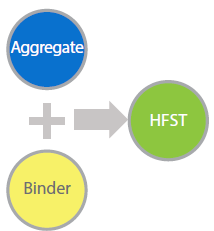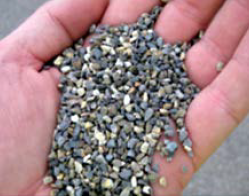HFST improves roadway surface friction by increasing pavement roughness. The treatment is composed of a thin layer of specially engineered, durable, high-friction aggregate bonded to the existing pavement by a thermosetting polymer resin binder as illustrated in Figure 4. The binder locks the aggregate firmly in place, creating an extremely rough, hard, durable surface capable of withstanding everyday roadway demands, such as heavy braking and even snowplowing. In fact, snowplowing can further roughen HFST by breaking the aggregate into more angular bits, which increases the pavements friction level even further.21, 22 This section will discuss the various aggregates and binders that can be used for HFSTs.
Figure 4. HFST Components.
3.1. HFST Aggregates
HFST aggregates, typically between 3 to 4 mm in size, come in different sizes with varying friction values and durability. Once the binder has been applied to the pavement surface, the aggregate is spread on top of the binder. Currently, calcined bauxite is the most widely used HFST aggregate in the United States and the only aggregate recommended by FHWA
Figure 5. Calcined Bauxite.

SOURCE: Federal Highway Administration
The National Center for Asphalt Technology (NCAT) report released in 2015 titled High Friction Surface Treatment Alternative Aggregates Study showed that of all aggregates tested, the calcined bauxite, shown in Figure 5, produced the greatest initial and long-term friction values, proving it to be the most durable and wear resistant aggregate used for HFST.23 All aggregates tested, and a description of their composition, included:
- Calcined bauxite is a mineral derived from aluminum ore that, when heated to a high temperature, increases in physical hardness and stability.
- Taconite is an iron bearing sedimentary rock that contains quartz, chert, or carbonate.
- Basalt is a volcanic rock formed by the rapid cooling of lava which is rich in magnesium and calcium oxides. It is one of the most common rocks found on Earth.
- Emery is a rock containing corundum (aluminum oxide) and iron oxide that has been used as an abrasive in products such as sandpaper.
- Flint silica is an oxide categorized as a microcrystalline variety of quartz. It occurs chiefly as nodules and masses in sedimentary rocks, such as chalk and limestone.
- Granite is a combination of quartz and potassium feldspar. Its mineral composition and interlocking crystals result in hardness and abrasion resistance.
- Silica sand is an oxide made up of broken down quartz crystals taken from sedimentary rocks that form naturally in nature.
- Steel slag is an impurity by-product of steel production, consisting of a complex solution of silicates and oxides.
3.2. Bonding Agents
HFST binder choice may be influenced by cost, climate, road volume, binder availability, and vendor selection. HFST's overall durability can vary as a result of the chosen binder, which are spread on the pavement surface before aggregate is applied.
Typical HFST binders are the following:24
- Epoxy-Resin is a binder system consisting of an epoxy resin and a hardener that are mixed together at the treatment site, most commonly in equal quantities by volume. This system possesses high strength and good adhesion properties to asphalt and concrete pavements. The epoxy system is waterproof after cure but requires a dry surface during the installation process. Currently, epoxy-resin is the most commonly used HFST binder and has shown good performance over time.
- Rosin-Ester is a thermoplastic binder applied to the aggregate during the manufacturing process, prior to delivery. On site, the dried aggregate binder mixture is heated causing the binder to melt. The melted binder bonds the aggregate to the pavement surface as it cools. The binder is ideal for rapid curing, allowing the roadway to reopen to traffic once the roadway surface reaches an ambient temperature.
- Polyurethane-Resin is a multi-component binder system that is most often mechanically mixed and dispensed on site. This binder retains some flexibility, reducing issues with brittleness and breakage. Polyurethane systems can be installed at cooler temperatures, but often have a sensitivity to any moisture present during the installation process.
- Methyl Methacrylate (MMA) is a two-component binder that can be mixed and spread either mechanically or manually over the treatment surface. MMA systems typically have lower strength than the other binder systems. The binder is waterproof after cure but is moisture-sensitive during curing. The advantage often considered for using an MMA binder system is its ability to gain strength and return traffic to the roadway quickly in cool temperatures.
- Polyester-Resin is a multi-component binder that is mixed and spread either mechanically or manually over the treatment surface. It retains high strength and is known to have better UV stability than many other systems. The binder is waterproof after cure but is moisture-sensitive during curing. The polyester system is reacted with a catalyst and an accelerating agent to adjust the rate of cure. This is advantageous in cooler temperatures as many other binder systems, such as epoxy, cure much slower in cooler temperatures.
Epoxy binder systems typically take the longest to cure in cooler temperatures. Catalyzed binder systems such as the MMA and polyester systems can be adjusted to cure faster in cooler temperatures. The curing times discussed in this section are estimated based on average ambient temperatures (approximately 70 degrees Fahrenheit). In comparatively colder or warmer climates, ideal binders for projects may vary due to temperature fluctuations.25 Table 3 summarizes binder curing times.
| Binder | Quickest Curing Time* | Curing Temperature |
|---|---|---|
| Epoxy-Resin | 3 – 4 hours | 70+F |
| Rosin-Ester | As soon as it reaches ambient temperature | ambient temperature |
| Polyurethane-Resin | 2.5 hours | |
| Methyl Methacrylate | 1.5 hours | <20F to 100+F |
| Polyester-Resin | 2 hours | <40F to 100+F |
*All manufactured binder systems have temperature limitations for installation. Read the individual manufacturer's requirements prior to use.
21 FHWA's Every Day Counts HFST - A Road Surface Treatment for Critical Safety Spot Locations that Helps Vehicles Stay in Their Lane. Available at: https://www.fhwa.dot.gov/everydaycounts. [ Return to note 21. ]
22 FHWA's High Friction Surface Treatments Frequently Asked Questions. Publication No. FHWA-CAI-14-019. [ Return to note 22. ]
23 National Center for Asphalt Technology, Asphalt Technology E-News. Volume 26, Number 2. Available at: https://eng.auburn.edu/research/centers/ncat/research/newsletters/atnspring2014.pdf. [ Return to note 23. ]
24 American Traffic Safety Services Association, Safety Opportunities in High Friction Surfacing. February 2013. [ Return to note 24. ]
25 American Traffic Safety Services Association, Safety Opportunities in High Friction Surfacing. February 2013. [ Return to note 25. ]
26 Ibid. [ Return to note 26. ]
